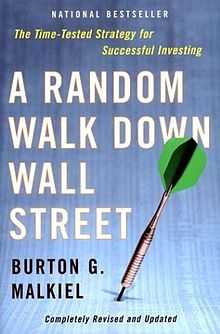A Random Walk Down Wall Street
 | |
| Author | Burton Malkiel |
|---|---|
| Country | United States |
| Language | English |
| Genre | Non-fiction |
| Publisher | W. W. Norton & Company, Inc. |
Publication date | 1973 |
| Pages | 456 pp. |
| ISBN | 0-393-06245-7 |
| OCLC | 72798896 |
| 332.6 22 | |
| LC Class | HG4521 .M284 2007 |
A Random Walk Down Wall Street, written by Burton Gordon Malkiel, a Princeton economist, is an influential book on the subject of stock markets which popularized the random walk hypothesis. Malkiel argues that asset prices typically exhibit signs of random walk and that one cannot consistently outperform market averages. The book is frequently cited by those in favor of the efficient-market hypothesis. As of 2012, there have been eleven editions.[1] A practical popularization is The Random Walk Guide to Investing: Ten Rules for Financial Success.[2]
Investing techniques
Malkiel examines some popular investing techniques, including technical analysis and fundamental analysis, in light of academic research studies of these methods. Through detailed analysis, he notes significant flaws in both techniques, concluding that, for most investors, following these methods will produce inferior results over passive strategies.
Malkiel has a similar critique for methods of selecting actively managed mutual funds based upon past performance. He cites studies indicating that actively managed mutual funds vary greatly in their success rates over the long term, often underperforming in years following their success, thereby reverting toward the mean. Malkiel suggests that given the distribution of fund performances, it is statistically unlikely that an average investor would happen to select those few mutual funds which will outperform their benchmark index over the long term.
Alternative view
In 1984 Warren Buffett gave a speech at Columbia University rebutting Malkiel's book and the Efficient Market Hypothesis. See The Superinvestors of Graham-and-Doddsville. As of 2013 Malkiel has not yet responded, and has ignored Buffett's argument. As Seth Klarman has stated: "Buffett's argument has never, to my knowledge, been addressed by the efficient-market theorists; they evidently prefer to continue to prove in theory what was refuted in practice".
But in 2014's letter "To the Shareholders of Berkshire Hathaway Inc.," (page 20) Buffett revealed his instructions in his will to the trustee for his wife's benefit: "Put 10% ... in short-term government bonds and 90% in a very low-cost S&P 500 index fund. (I suggest Vanguard’s.) I believe the trust’s long-term results from this policy will be superior to those attained by most investors – whether pension funds, institutions or individuals – who employ high-fee managers."
References
- ↑ Burton Malkiel (2011) A random walk down Wall Street: the time-tested strategy for successful investing
- ↑ Hardback: ISBN 978-0-393-05854-3, Paperback: ISBN 978-0-393-32639-0
External links
- Review of A Random Walk Down Wall Street - from Bainvestor.com - HCM Publishing, Peter I. Hupalo.
- Une marche au hasard à travers la Bourse, French translation by Éric Pichet.